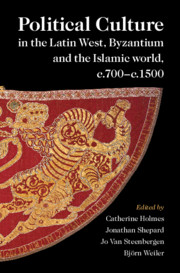 Political Culture in the Latin West, Byzantium and the Islamic World, c.700–c.1500
Political Culture in the Latin West, Byzantium and the Islamic World, c.700–c.1500 Book contents
- Political Culture in the Latin West, Byzantium and the Islamic World, c.700–c.1500
- Political Culture in the Latin West, Byzantium and the Islamic World, c.700–c.1500
- Copyright page
- Contents
- Figures and Maps
- Contributors
- Preface and Acknowledgements
- Abbreviations
- General Maps
- 1 Political Culture in Three Spheres
- 2 Reflections on Political Culture in Three Spheres
- Part I Sources
- Part II Historical Contexts
- 7 The Latin West
- 8 Byzantium
- 9 The Islamic World
- Part III Norms, Values and Their Propagation
- Part IV Practice and Organisation
- Part V Conclusions
- Appendix
- Glossary
- Index
8 - Byzantium
One or Many?
from Part II - Historical Contexts
Published online by Cambridge University Press: 11 August 2021
- Political Culture in the Latin West, Byzantium and the Islamic World, c.700–c.1500
- Political Culture in the Latin West, Byzantium and the Islamic World, c.700–c.1500
- Copyright page
- Contents
- Figures and Maps
- Contributors
- Preface and Acknowledgements
- Abbreviations
- General Maps
- 1 Political Culture in Three Spheres
- 2 Reflections on Political Culture in Three Spheres
- Part I Sources
- Part II Historical Contexts
- 7 The Latin West
- 8 Byzantium
- 9 The Islamic World
- Part III Norms, Values and Their Propagation
- Part IV Practice and Organisation
- Part V Conclusions
- Appendix
- Glossary
- Index
Summary
This chapter outlines the geographical and chronological contexts of the Byzantine sphere, stressing the role that terrestrial and maritime geography played in the relationship between the imperial centre at Constantinople and the frontiers, as well as in diplomacy. It charts gradual territorial expansion, growth in the economy and flourishing of the church, particularly monasteries, between c.700 and 1050, followed by imperial collapse in the eleventh century, the consolidation of a smaller imperial space in the twelfth and political fragmentation thereafter. It considers the role played by societies and polities beyond the empire in the wider Byzantine sphere, a sphere far from culturally homogeneous. Attention is paid to the principal political formations within the empire itself, emphasising the relationship between formal and informal power. The key co-ordinates of formal Byzantine political society – emperor, palace, eunuchs, bureaucracy – are identified, but attention is also paid to those whose agency in political life was highly significant, if less frequently discussed: kinship and friendship networks, women, urban communities and charismatic holy figures.
Keywords
- Type
- Chapter
- Information
- Political Culture in the Latin West, Byzantium and the Islamic World, c.700–c.1500A Framework for Comparing Three Spheres, pp. 178 - 211Publisher: Cambridge University PressPrint publication year: 2021
